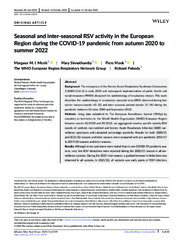Приказ основних података о документу
Seasonal and inter-seasonal RSV activity in the European Region during the COVID-19 pandemic from autumn 2020 to summer 2022
| dc.creator | Meslé, Margaux M. I. | |
| dc.creator | Sinnathamby, Mary | |
| dc.creator | Mook, Piers | |
| dc.creator | Pebody, Richard | |
| dc.creator | Protić, Jelena | |
| dc.date.accessioned | 2023-11-22T22:35:12Z | |
| dc.date.available | 2023-11-22T22:35:12Z | |
| dc.date.issued | 2023 | |
| dc.identifier.issn | 1750-2659 | |
| dc.identifier.uri | http://intor.torlakinstitut.com/handle/123456789/846 | |
| dc.description.abstract | Background The emergence of the Severe Acute Respiratory Syndrome Coronavirus 2 (SARS-CoV-2) in early 2020 and subsequent implementation of public health and social measures (PHSM) disrupted the epidemiology of respiratory viruses. This work describes the epidemiology of respiratory syncytial virus (RSV) observed during two winter seasons (weeks 40–20) and inter-seasonal periods (weeks 21–39) during the pandemic between October 2020 and September 2022. Methods Using data submitted to The European Surveillance System (TESSy) by countries or territories in the World Health Organization (WHO) European Region between weeks 40/2020 and 39/2022, we aggregated country-specific weekly RSV counts of sentinel, non-sentinel and Severe Acute Respiratory Infection (SARI) surveillance specimens and calculated percentage positivity. Results for both 2020/21 and 2021/22 seasons and inter-seasons were compared with pre-pandemic 2016/17 to 2019/20 seasons and inter-seasons. Results Although more specimens were tested than in pre-COVID-19 pandemic seasons, very few RSV detections were reported during the 2020/21 season in all surveillance systems. During the 2021 inter-season, a gradual increase in detections was observed in all systems. In 2021/22, all systems saw early peaks of RSV infection, and during the 2022 inter-seasonal period, patterns of detections were closer to those seen before the COVID-19 pandemic. Conclusion RSV surveillance continued throughout the COVID-19 pandemic, with an initial reduction in transmission, followed by very high and out-of-season RSV circulation (summer 2021) and then an early start of the 2021/22 season. As of the 2022/23 season, RSV circulation had not yet normalised. | |
| dc.language | en | |
| dc.publisher | Wiley | |
| dc.relation | The WHO Regional Office for Europe was supported for work on influenza and other respiratory viruses by a cooperative agreement from the United States Centers for Disease Control and Prevention (NU51IP000936) | |
| dc.rights | openAccess | |
| dc.rights.uri | https://creativecommons.org/licenses/by/4.0/ | |
| dc.source | Influenza and Other Respiratory Viruses | |
| dc.subject | COVID-19 pandemic | |
| dc.subject | epidemiology | |
| dc.subject | Europe | |
| dc.subject | respiratory syncytial virus | |
| dc.subject | severity | |
| dc.subject | surveillance | |
| dc.title | Seasonal and inter-seasonal RSV activity in the European Region during the COVID-19 pandemic from autumn 2020 to summer 2022 | |
| dc.type | article | en |
| dc.rights.license | BY | |
| dc.citation.issue | 11 | |
| dc.citation.rank | M22~ | |
| dc.citation.spage | e13219 | |
| dc.citation.volume | 17 | |
| dc.contributor.count | Group, The WHO European Region Respiratory Network | |
| dc.identifier.doi | 10.1111/irv.13219 | |
| dc.identifier.fulltext | http://intor.torlakinstitut.com/bitstream/id/2004/bitstream_2004.pdf | |
| dc.type.version | publishedVersion |

